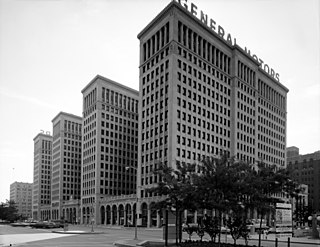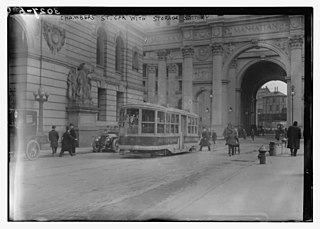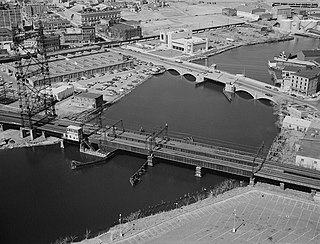Related Research Articles

The New York, New Haven and Hartford Railroad, commonly known as The Consolidated, or simply as the New Haven, was a railroad that operated in the New England region of the United States from 1872 to December 31, 1968. Founded by the merger of the New York and New Haven and Hartford and New Haven railroads, the company had near-total dominance of railroad traffic in Southern New England for the first half of the 20th century.

The General Motors streetcar conspiracy refers to the convictions of General Motors (GM) and related companies that were involved in the monopolizing of the sale of buses and supplies to National City Lines (NCL) and subsidiaries, as well as to the allegations that the defendants conspired to own or control transit systems, in violation of Section 1 of the Sherman Antitrust Act. This suit created lingering suspicions that the defendants had in fact plotted to dismantle streetcar systems in many cities in the United States as an attempt to monopolize surface transportation.

The Connecticut Trolley Museum, founded in October 1940, is the oldest incorporated museum dedicated to electric railroading in the United States. The museum is located in East Windsor, Connecticut and is open to the public April through December. The museum features static and moving displays, and self-guided tours of the state's trolley history.

New York State Railways was a subsidiary of the New York Central Railroad that controlled several large city streetcar and electric interurban systems in upstate New York. It included the city transit lines in Rochester, Syracuse, Utica, Oneida and Rome, plus various interurban lines connecting those cities. New York State Railways also held a 50% interest in the Schenectady Railway Company, but it remained a separate independent operation. The New York Central took control of the Rochester Railway Company, the Rochester and Eastern Rapid Railway and the Rochester and Sodus Bay Railway in 1905, and the Mohawk Valley Company was formed by the railroad to manage these new acquisitions. New York State Railways was formed in 1909 when the properties controlled by the Mohawk Valley Company were merged. In 1912 it added the Rochester and Suburban Railway, the Syracuse Rapid Transit Railway, the Oneida Railway, and the Utica and Mohawk Valley Railway. The New York Central Railroad was interested in acquiring these lines in an effort to control the competition and to gain control of the lucrative electric utility companies that were behind many of these streetcar and interurban railways. Ridership across the system dropped through the 1920s as operating costs continued to rise, coupled with competition from better highways and private automobile use. New York Central sold New York State Railways in 1928 to a consortium led by investor E. L. Phillips, who was looking to gain control of the upstate utilities. Phillips sold his stake to Associated Gas & Electric in 1929, and the new owners allowed the railway bonds to default. New York State Railways entered receivership on December 30, 1929. The company emerged from receivership in 1934, and local operations were sold off to new private operators between 1938 and 1948.

Streetcars in Washington, D.C. transported people across the city and region from 1862 until 1962.

CTtransit is a bus system serving much of the U.S. state of Connecticut and is a division of that state's Department of Transportation. CTtransit provides bus service via contract providers for seven different metropolitan areas in the state, mostly concentrated in Hartford and New Haven counties. CTtransit began operations in 1976.

The Third Avenue Railway System (TARS), founded 1852, was a streetcar system serving the New York City boroughs of Manhattan and the Bronx along with lower Westchester County. For a brief period of time, TARS also operated the Steinway Lines in Long Island City.

The Connecticut Company was the primary electric street railway company in the U.S. state of Connecticut, operating both city and rural trolleys and freight service. It was controlled by the New York, New Haven and Hartford Railroad, which also controlled most steam railroads in the state. After 1936, when one of its major leases was dissolved, it continued operating streetcars and, increasingly, buses in certain Connecticut cities until 1976, when its assets were purchased by the state government.

The New York Railways Company operated street railways in Manhattan, New York City, United States between 1911 and 1925. The company went into receivership in 1919 and control was passed to the New York Railways Corporation in 1925 after which all of its remaining lines were replaced with bus routes.

The Connecticut Railway and Lighting Company Car Barn was historic streetcar maintenance facility in Bridgeport, Connecticut. Built in 1910 and enlarged in 1920, it served as a maintenance barn first for electric streetcars and then buses for many years, and was one of the few surviving reminders of the city's early public transit system. The building was listed on the National Register of Historic Places on December 3, 1987. It was demolished in 2008 to make way for construction of the Connecticut Superior Court juvenile facility that now stands on its site.

The Charlottesville and Albemarle Railway (C&A) was a short electric street railroad operating within the city of Charlottesville, Virginia, United States, during the early 20th century. The line was preceded by several streetcar lines operating both horse-drawn and electric powered cars dating back to 1887. After facing financial difficulties, the predecessor lines were reorganized into the C&A in 1903. The C&A's electric streetcars operated off of an overhead line system that was powered by the railroad's own power plant. The C&A also offered electric power generated by its plant to the city of Charlottesville. During the mid-1910s, the line received numerous upgrades, including the construction of a new power plant on the Rivanna River, a new company headquarters building, expansion of track, and the purchase of new streetcars.
The Rochester Railway Company operated a streetcar transit system throughout the city of Rochester from 1890 until its acquisition by Rochester Transit Corp. in 1938. Formed by a group of Pittsburgh investors, the Rochester Railway Company purchased the Rochester City & Brighton Railroad in 1890, followed by a lease of the Rochester Electric Railway in 1894. The Rochester and Suburban Railway was leased in 1905, extending the system's reach to Irondequoit and Sea Breeze. Rochester Railways was acquired by the Mohawk Valley Company, a subsidiary of the New York Central Railroad set up to take control of electric railways in its territory. In 1909 the holdings of the Mohawk Valley Company were consolidated as the New York State Railways.

The New York and Stamford Railway was a streetcar line that connected the Westchester County suburbs of New Rochelle, Larchmont, Mamaroneck, Harrison, Rye, and Port Chester, with the Connecticut suburbs of Greenwich and Stamford. The company was formed in 1901 when the New York, New Haven and Hartford Railroad combined the Larchmont Horse Railway Company with the Port Chester Street Railroad Company. The Larchmont Horse Railway Company was founded in 1888 by the Larchmont Manor Company to construct a line from the New York, New Haven and Hartford Railroad Larchmont train station to its development 1.2 miles from town. The line was rebuilt for electric operation and extended to Harrison in 1901. The Port Chester Street Railroad opened in 1898 serving Port Chester, New York. The trolley line was soon extended west through Rye to Harrison in 1901. The two companies were merged that summer to form the New York and Stamford Railway. Trackage rights over the Westchester Electric Railroad were obtained for access to New Rochelle.

The Danbury and Bethel Street Railway was a streetcar transit operator serving the greater Danbury, Connecticut, area, originally chartered in 1886. It was one of the few trolley companies to remain independent of the Connecticut Company consolidation of transit lines throughout the state. Electric trolley service between Danbury and Bethel began in 1887. The streetcar line connected to the Danbury and Harlem Traction Company at the Fairgrounds, but no service was provided and the line was abandoned by 1910. The Danbury and Bethel Street Railway faced its first financial difficulties in 1914 as ridership declined with the closure of local factories. The construction of an aborted extension to Bridgeport had nearly exhausted the railway's cash reserves. The company was purchased by J. Moss Ives in 1918 with the intention of bringing the operation back to profitability. The first buses were ordered and put into operation in 1912 between Main Street and Lake Avenue in Danbury. Ives reorganized as the Danbury and Bethel Traction Company in 1925. When the proposal to replace all remaining streetcar lines with bus operation was announced, the trolley motormen all went on strike in November 1926. The work stoppage did not affect the transition, and by the end of 1926 all streetcar operation had been abandoned, making it the first line in Connecticut to completely convert to bus operation.
Connecticut Railway and Lighting Company was a streetcar and bus transit operator serving the region around Bridgeport, Norwalk, Derby, New Britain and Waterbury, Connecticut. It was formed in 1901 by United Gas Improvement Company of Philadelphia to manage the streetcar operations of the Connecticut Light and Power Company, which at the time included Central Railway and Electric Company, Norwalk Street Railway, and the Waterbury Traction Company. The newly formed Connecticut Railway and Lighting acquired Bridgeport Traction Company, Derby Street Railway, Milford Street Railway, Shelton Street Railway, Meriden, Southington and Compounce Tramway Company, and the Cheshire Street Railway. Connecticut Railway and Lighting was leased to the Consolidated Railway and in turn the Connecticut Company between 1906 and 1936. Streetcar operations were discontinued in 1937 when all lines were converted to bus. Transit operations continued until 1972, when all remaining bus operations were suspended and taken over by Connecticut Transit, except in Bridgeport- by the Greater Bridgeport Transit District in 1975.
The Waterbury Traction Company was a streetcar transit operator serving the region around Waterbury, Connecticut. Originally formed in 1884 as the Waterbury Horse Railroad Company, which began service in 1886. The company was reorganized in 1893 as the Waterbury Traction Company, rebuilding and electrifying its routes by the summer of 1894.

The United Electric Railways Company (UER) was the Providence-based operator of the system of interurban streetcars, trolleybuses, and trolley freight in the state of Rhode Island in the early- to mid-twentieth century.

The Boston & Northern Street Railway Company (B&N) was a horse-drawn and electric streetcar railroad operated on the streets of Boston, Massachusetts, and communities to the north. Founded in 1859 as the Lynn and Boston Railroad (L&B), via lease and merger it became a primary mass transit provider for northeastern Massachusetts and New Hampshire. Its immediate successor was the Bay State Street Railway (Bay State), and its modern successor is the state-run Massachusetts Bay Transportation Authority (MBTA).
References
- ↑ Report of the Board of Railroad Commissioners, the Tax Commissioner and the Bank Commissioner, Sitting as a Commission, Relative to the Assets and Liabilities of the New York, New Haven & Hartford Railroad Company, Feb. 15, 1911. Wright & Potter Printing Co. 1911. p. 339.
- ↑ Western Connecticut Trolleys - Connecticut Motor Coach Museum. 2007-02-28. ISBN 9780738549699 . Retrieved 2012-03-01.
- ↑ "OYSTER TRUST IS FORMED. - Capital Over $5,000,000 - All the Grounds Supplying the Market Here Will Probably Change Hands. - Article - NYTimes.com". Select.nytimes.com. 2012-02-25. Retrieved 2012-03-01.
- ↑ Hartford Courant, Conn. Co. Will Quit Leased Lines Monday, November 14, 1936, p. 1
- ↑ The New York Times , Buses for Bridgeport, February 10, 1937, p. 5